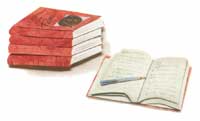
How Diversity Helps Literacy

Ethnicity and Literacy
The importance of showcasing diversity in books for
children has grown as the ethnic makeup of the population in the United
States has changed. Among school-aged children, 20% are Hispanic and 15%
are African American.[i] The realm of books, however, is far more
homogeneous; only 5% of children's books are by or about Africans or
African Americans, and merely 2% are by or about Hispanics.[ii]
When teaching to this diverse population, educators not only face the
challenge of providing multicultural books
that all children can identify with, they must also respond to various
levels of literacy in the home. African American and Hispanic adults are
less likely to have a college degree than white or Asian American
adults,[iii] and children whose parents are college-educated are more
likely to be read to at home.[iv]
Studies have shown that being read to and having access to books are
important factors in a child’s educational success.[v] In school,
African American and Hispanic students get fewer A’s and more D’s and
F’s than other students.[vi] Responsible educators are seeking ways
to close this gap—but why look at picture books?
In one telling study, a group of African American students overwhelmingly named multicultural books that highlight African American characters and their families, and deal with issues of prejudice or discrimination, as being their favorite books. In contrast, they gave low ratings to books that ignore issues of ethnicity.[vii] Another study shows that "being more enthusiastic about reading and a frequent reader was more of an advantage, on its own, than having well-educated parents in good jobs.”[viii] Making books with characters and situations that students can identify with, and which are accessible to them, greatly increases success.
Building Literacy in English Language Learners
Not only are today's classrooms full of minority students, educators
are faced with linguistically diverse schools. Nearly 70% of Hispanic
and Asian American children speak languages other than English at home,
and 15–20% have difficulty with English.[ix]
Given that being an enthusiastic reader is more important than parents’ education or income, books in the language most accessible to a child can make all the difference.
Notes
[i] Forum on Child and Family Statistics. “America's Children: Key
National Indicators of Well Being, 2007.”
http://childstats.gov/americaschildren/ (Accessed September 27, 2007)
[ii] Cooperative Children's Book Center. "Children's Books By and
About People of Color Published in the United States."
http://www.education.wisc.edu/ccbc/books/pcstats.htm. (Accessed October
4, 2007).
[iii] U.S. Census Bureau. “Educational Attainment: 2000.”
http://www.census.gov/prod/2003pubs/c2kbr-24.pdf (Accessed September 27,
2007)
[iv] Forum on Child and Family Statistics. “America's Children: Key
National Indicators of Well-Being, 2007”
http://childstats.gov/americaschildren/ (Accessed September 27, 2007)
[v] Jeanine Asche. “Literacy Facts and Statistics.” San Mateo County
Library. http://www.smcl.org/services/RAR/Statistics.html (Accessed
September 27, 2007).
[vi] Institute of Educational Sciences, U.S. Department of
Education. “Digest of Educational Statistics, 2006.” National Center
for Education Statistics. http://nces.ed.gov/programs/digest/d06/
(Accessed September 27, 2007)
[vii] Kira Isak Pirofski. “Multicultural Literature and the
Children’s Literary Canon.” EdChange Multicultural Pavilion.
http://www.edchange.org/multicultural/papers/literature.html (Accessed
September 27, 2007)
[viii] Sarah Cassidy. “Reading at Home ‘Is Key to Success’ for
Children.” The Independent. November 20, 2002.
[ix] Forum on Child and Family Statistics. “America's Children: Key
National Indicators of Well-Being, 2007”
http://childstats.gov/americaschildren/ (Accessed September 27, 2007)
Contact Us
Telephone: (212) 779-4400 x 28
Email: quotes[at]leeandlow[dot]com
Educator's Newsletter: Subscribe
FREE Teacher's Guides
Helpful educator resources can be found at our Educators






